The Zodiac Testifies of Christ
Published as “The Constellations Tell of Christ,” by Meridian Magazine (15 Jun 2005).
©2005 by John P. Pratt. All rights Reserved.
| 1. The Gospel in the Stars |
| 1.1 Order |
| 1.2 Dual Symbolism |
| 2. The Messiah |
| 2.1 The Savior |
| 2.2 Great High Priest |
| 2.3 Son of God |
| 3. The Redeemer |
| 3.1 Great Sacrifice |
| 3.2 Deliverer |
| 3.3 Resurrection |
| 4. King of Kings |
| 4.1 Judge |
| 4.2 Lawgiver |
| 4.3 Lord of Hosts |
| 5. Conclusion |
| Notes |
The zodiac constellation figures may symbolize the twelve key roles of Jesus Christ.
The Book of Enoch records that the angel Uriel revealed the figures in the stars called the constellations to the prophet Enoch. There is much evidence to support that claim, such as many of the figures being the same symbols used throughout the scriptures to represent the Savior Jesus Christ and elements of his gospel. Several books have been written summarizing the concept that the gospel story appears to be shown in the stars. This article presents new evidence that in addition to that gospel presentation, the twelve figures in the group of constellations called the zodiac also summarize the twelve principal roles that Jesus Christ would fulfill.
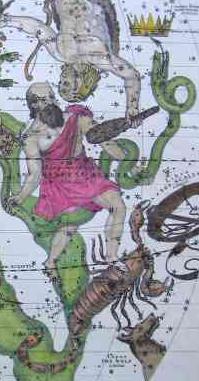 |
Before we look at these proposed roles of Jesus Christ, the reader is encouraged to write a quick list of his most common titles and then ponder exactly what each means. For example, what did Jesus do which qualified him to be called the Savior, or the Redeemer or the Messiah? Is there any difference between the roles of Savior and Deliverer? When I began the research for this article, my understanding was that those two titles were synonymous, but now it is clear from the zodiac figures that those roles are very different from each other. They will never be the same again to me. What is your understanding? Is it possible that you too could learn something about the Gospel of Jesus Christ from these ancient symbols? What were the most important tasks for the Savior to accomplish?
1. The Gospel in the Stars
Let us begin by briefly summarizing previous work which claims that the gospel seems to be clearly shown in the star figures. The principal work was done by a nineteenth century woman named Frances Rolleston. Her original work has recently been republished,[1] but it is rather cumbersome because it is largely a set of research notes. Two Christian scholars summarized her work, added to it, and presented it in a much more palatable form about a century ago.[2] There are many flaws in the work,[3] but it appears that they got the basic idea correct. That is, the constellations testify of Christ and tell the gospel story in picture form. There is a surprising amount of information in the Bible supporting this hypothesis.
It has been shown from strictly scientific arguments that the constellations, as transmitted to us by the ancient Greeks, originated about 2900 B.C. at a location of about 30° north latitude.[4] That means they are extremely ancient, being over 2,000 years older that the Greeks at their prime. That fits the Hebrew tradition perfectly that they were drawn by prophets before the Great Flood, and in particular, that they originated with the prophet Enoch, who would have lived about that time.
Traditionally there were 48 constellations in the original set: 12 principal constellations in a circle around the entire sky called the zodiac, with three other constellations called decans which accompanied each of those twelve.[5] Generally there is good agreement between ancient nations on just what those 48 are, but there have been minor disagreements on three or four of them. One seems to have been entirely lost, but it may have been recently restored.[6]
 |
How did we get the constellations? The traditional story, which I have not verified in detail, is that the constellation maps and descriptions were given to Abraham, who also had his own revelations on the subject, and who transmitted the knowledge to the Egyptians. After having been preserved for 2,000 years in Egypt, the knowledge was received by the Greeks. In particular, a globe with a map of the heavens was taken from the Egyptian temple which fell into the hands of the Greek scholar Eudoxus. His detailed description of that globe has been lost, but it was preserved in poetic form by Aratus. Thus, it is this author’s position that the set of constellations which we inherited from the Greeks is not a bad approximation to the original set which was indeed revealed to Enoch.
Now let us briefly review the interpretation of the symbols as representing the gospel of Christ, given in chronological order around the circle. Remember that volumes have been written on this subject, but an overview here will summarize the idea.
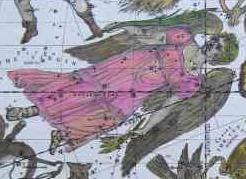 |
1. The Maiden (Virgo). This constellation, perhaps better named “The Virgin’s Seed,” depicts a winged virgin holding some wheat, with the only bright star being located in the wheat. The three decans of the Infant Prince (Coma, the lost constellation), the Herdsman (Bootes), and the Centaur (Centaurus) make it clear that it is her seed which is most important in this figure. That is, the seed of wheat represents her infant, who is half god and half man, and who will become the Good Shepherd.
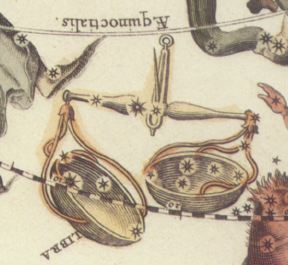 |
2. The Scales (Libra). This constellation is often said to have been originated by the Romans because it is not described by the Greeks. But it truly seems to have been in the original set because it has been found in the ancient Sumerian and Babylonian records dating to about 2,000 BC. Before there were coins, payments were made by weighing out commodities on a balance scale. Thus, the proposed meaning is that it represents the role of Christ as the Redeemer, who paid for our sins with his suffering, and who literally bought us with his blood.
3. The Scorpion (Scorpius). This killer is shown stinging the heel of the Serpent Bearer (Ophiuchus) who in turn is crushing the scorpion’s head. This is so reminiscent of the great promise given to Eve that her seed would crush the serpent’s head, even though it would bruise his heel (Gen. 3:15). That is, her descendant Jesus Christ would overcome death, hell and Satan, even though he would be crucified by the forces of evil.
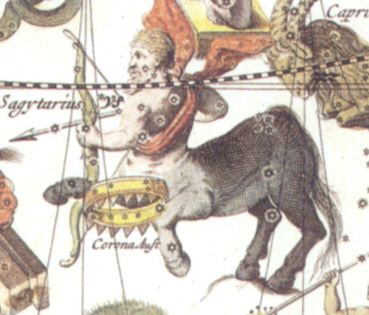 |
4. The Archer (Sagittarius). The archer is a centaur (half man, half horse), which might represent the dual nature of Christ, being half god and half human. It is shown shooting the scorpion, overcoming the adversary. It’s decans suggest rejoicing at the great victory.
5. The Sea-Goat (Capricornus). Some of the strangest constellations actually become the easiest to interpret. The goat is wounded, and some of the star names indicate that it is a sacrificial goat. This most likely represents Christ as the Great Sacrifice. The tail of the animal is that of a fish which appears very much alive, and which may represent its subsequent resurrection.
6. The Water Bearer (Aquarius). Here is a man pouring out an entire stream of water from a small jar onto the head of the Southern Fish (Piscis Australis). This appears to represents Christ pouring out blessings and revelations onto his Church.
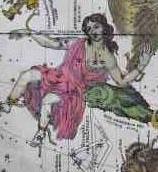 |
7. The Fishes (Pisces). To me this set of constellations is the clearest, and it convinced me that the gospel is indeed portrayed in the heavens. There are two fish tied by their tails with bands to the great Sea Monster (Cetus). Again, the fish most likely represent Christians, being in bondage to death and hell. The decan of the Chained Princess, Andromeda, repeat this symbolism, being chained to a cliff as a sacrifice to the same Sea Monster.
8. The Ram (Aries). Here the Ram has his leg extended to the bands holding the Fishes, perhaps representing breaking the bands of death. He also has one foot on the head of the Sea Monster. Christ breaking the bands of death is a common motif in scripture.
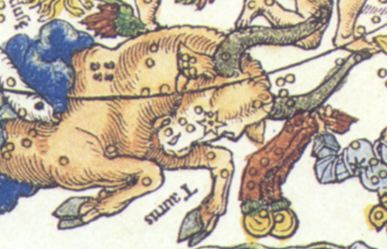 |
9. The Bull (Taurus). The white Bull is a mighty animal, being an extinct type of wild ox. It is clearly used in the book of Enoch to symbolize the Kingdom of God in the Millennial reign.
10. The Twins (Gemini). Rolleston suggested that the twins show the human and divine nature of Christ. To me that was shown well enough by the Centaur, and I have thought the Twins might represent that the hero of the First Coming and the Second Coming are the same person. Yet another interpretation is suggested in this article.
11. The Crab (Cancer). This has been the most difficult figure to explain. I lean toward Rolleston’s explanation: The crab represents the Savior tenaciously holding onto his flock after having purchased them, so that no one can pluck them from his hand.
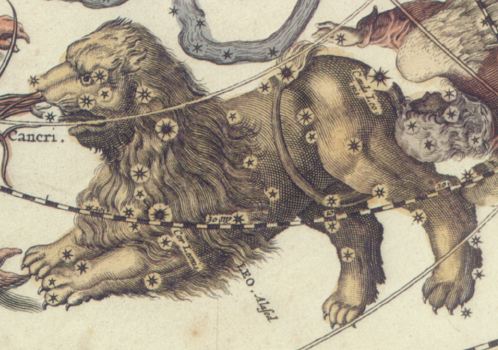 |
12. The Lion (Leo). The king of beasts is chasing its prey of the Fleeing Serpent (Hydra), and to Rolleston represents the final victory of good over evil at the end of the Millennium.
To me the case is compelling that these symbols do indeed speak of Christ, but there are many questions yet to be answered. I have written a more detailed summary and book review of the books on this subject,[7] as well as attempted to respond to objections to the theory.[8] Moreover, I have written a detailed article on the four cornerstone constellations, the Lion, Bull, Man, and Eagle (counterpart of the Serpent/Scorpion)[9] and their principal stars.[10]
1.1 Order
What is the order of these twelve constellations? To me that must be explained well to show the design of the entire set. Joseph Seiss suggested that it is basically a chronological order, with the first four constellations representing the First Coming of Christ, from the virgin birth through the conquering of death and hell. He associated the second four with Christ’s relationship to his Church, and the last four with the Second Coming, ending with the final victory of Satan as the Lion chases out the Fleeing Serpent (Hydra), with his feet nearly on its head.
He may well be correct. For example, the white bull is the symbol in the Book of Enoch for the political Kingdom of God which is set up at the bringing of the Millennium, complete with the return of the City of Enoch.[11] But I have been looking for an even more convincing order, because God’s house is a house of order, and if these constellations are of divine origin, then they must be highly ordered.
1.2 Dual Symbolism
Perhaps the key factor which led to the research resulting in the discovery being announced in this article is that some of the symbols can represent both good and evil. Take, for example, the serpent. Sometimes it represents Satan (as in Rev. 12:9) and sometimes it represents Christ (as when the brass serpent was raised on the pole by Moses, Num. 21:9). The tribe of Dan used the serpent as its symbol (inspired by Gen. 49:17). It is Hebrew tradition that each of the 12 tribes of Israel was associated with one of the twelve signs of the zodiac, and that some tribes adopted the zodiac figure as their tribal symbol displayed on their flag. Hebrew scholars only agree on four or five of these associations, and those are the ones clearly indicated by allusions in the blessings given to the twelve sons of Jacob both by Jacob (Gen. 49) and Moses (Deut. 33). In an earlier paper, this association was discussed in detail for the principal four constellations and tribes.[12]
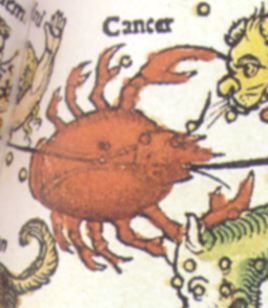 |
Another figure usually associated with evil is the Crab, which also attacked a hero’s foot according to the Greek myths, even as had the Scorpion. If the Lord really intended each of the tribes of Israel to be associated with a zodiac constellation (Gen. 37:9-10), then it was clear to me that none of the tribes would be given evil emblems to inspire them. All of the previous research in this field had claimed that some of the figures represented Christ, such as the Lion as the King of Kings, and the Ram as breaking the Bands of Death, but that clearly the Scorpion was the adversary, representing evil. To me, it had to be that all twelve of the symbols represented at least one aspect of Christ so that each of the tribes would have a positive image.
Let us now turn to a modified interpretation of these same twelve symbols. These are offered in addition to what has already been proposed, not as a replacement. These figures most likely have many layers of deep meanings. These twelve are proposed only as an introduction to a new way of looking at the signs of the zodiac.
The purpose of this paper is to propose that the twelve constellations of the zodiac represent twelve specific roles of the Savior, using the terminology by which he is called in the Bible. They are divided into three groups of four. Each group has a heading with three subdivisions. The three headings are the constellations numbers #12, 1 and 2, and the four in each group are evenly spacing around the circle. Thus, the four are located in four perpendicular directions like North, East, South and West on the points of a circular compass. For example, the three that go with #1 are #4, #7 and #10, as shown in Figure 1.
 |
2. The Messiah
The first constellation of the Virgin’s Seed (or the Maiden, Virgo, #1) clearly refers to the infant Christ as one of its meanings.[13] It represents many titles which have been given him: The Hope of Israel (Jer. 17:13) , The Royal Heir (Mat. 21:38, Heb. 1:2), but most especially the Messiah (Dan. 9:25), which means Anointed (Hebrew), which is translated as “Christ” into Greek. All of these refer to a hope that this infant is the promised child that would do all necessary to overcome evil, solve all of our problems, and be our leader. This constellation serves as a heading for three others. These other three constellations in this set identify three very different roles for the Messiah to fulfill.
2.1 The Savior
The Archer (Sagittarius, #4) who is slaying the Scorpion apparently depicts the role of Christ as Savior in the sense that he slays the enemy and preserves life. The word “Savior” is used to describe Jesus Christ often in the New Testament (Luke 2:11, John 4:42, Acts 5:31), and Jehovah in the Old Testament (Isa. 43:3,11; 49:26; Jer. 14:8) This entire role is further subdivided into separate tasks, as explained below.
2.2 The Great High Priest
Jesus is also the Great High Priest (Heb. 4:14), the Holy one of Israel (Isa. 41:14), the head of his Church (Eph. 5:23), and of his Priesthood (Jos. 18:7). One meaning of the constellation of the Fishes (Pisces, #7) is that the two fish represent the Christian Church at two different times, the fish nearer the Ram being the Church at the time of Jesus Christ, and the other Fish being his Church in the last days. If so, then the relationship of these Churches to Christ is that he is their head, as the Great High Priest.
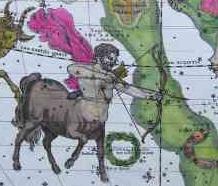 |
2.3 The Son of God
Another huge role of Jesus Christ is that of being the literal Son of God, obediently fulfilling the will of his Heavenly Father and being an example for all of us to follow. That role also has all of the implications of being the Royal Prince, the Heir to the Throne of the Father. It is here proposed that this aspect of Christ may be one of the meanings of the Twins (Gemini, #10). This is a new interpretation, but it appears best to me at this time. We are told that Christ was created in the exact similitude of his father (John 14:9), which would account for the “twins” concept. Another interpretation is the Twins represent Christ at the First Coming (with the star Pollux at the head) and at the Second Coming (headed by the star Castor).
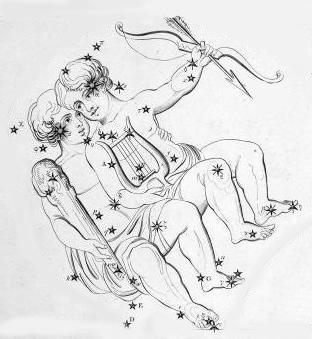 |
This constellation seems to have many layers of meaning, as do all of them. It may also represent the Savior’s role as both Father and Son. Here it is important not to confuse Christ’s role as father with that of his (and our) Father in Heaven. Jesus Christ is the Father of the heavens and the earth, and of all therein (Col. 1:16). That role of “father” is essentially the same as “Creator.” He also becomes the father of those who join his Church by being baptized by one having authority. More research is required to understand this constellation more fully.
3. The Redeemer
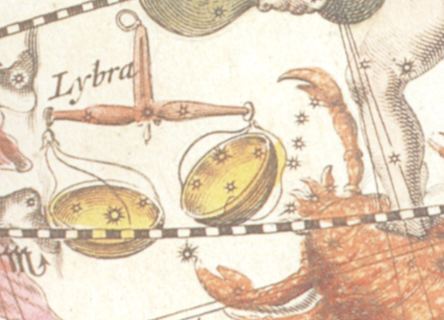 |
As far as I know, all writers on this subject have agreed that the Balance or Scales (#2, Libra) represents the price of sin being paid by the suffering of Jesus Christ in his role as Redeemer (Isa. 41:14, 48:17). The word “redeem” means to pay the price to reclaim something, such as redeeming a coupon or paying the ransom to free someone from bondage. The scale is an ideal picture to convey this idea. Moreover, one can break the redemption process into three distinct steps. Consider the process of freeing a kidnapped hostage. The steps can be thought of as 1) pay the ransom price, 2) get the hostage and remove him from the prison, and finally 3) set the hostage free. These three steps are illustrated in the accompanying zodiac constellations.
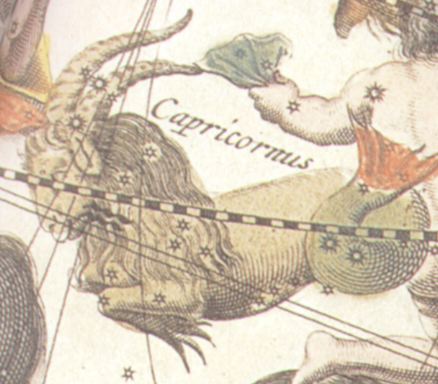 |
3.1 The Great Sacrifice
Authors on this subject also agree that the Sea-Goat (#5, Capricornus) represents a sacrificial goat. It was not just lambs which were sacrificed in the law of Moses to represent the Savior, but sometimes it was a goat. Specifically, in the ritual on the Day of Atonement, the animal that represented the Lord that was sacrificed for the sins of Israel was a goat (Lev. 16:9).
Some of the star names explicitly refer to this goat as being for sacrifice. The second star in the head, Dabih (Beta Cap), means “the Slaughtering One.” This translation was not taken from Rolleston’s work, whose translations cannot be trusted in general, but from perhaps the foremost modern expert on Star Names, Paul Kunitzsch.[14]
Our Redeemer paid the price to buy us with his blood with his great suffering, which was all part of his being the Great Sacrifice that would be offered in payment for our souls (John 1:29, Eph. 5:2, Rev. 5:6). It began in the Garden of Gethsemane when he suffered for our sins, and ended with his suffering on the cross, when he gave his life that we could have everlasting life, which would be attained after he had accomplished the next two tasks.
3.2 The Deliverer
The constellation Cancer (#11, Cancer) has been one of the toughest to understand. It is shown simply as a Crab (the meaning of the Latin word “cancer”). In ancient Egypt, this constellation was sometimes represented as a Scarab beetle, which was associated with immortality, but the symbolism has been somewhat obscure.
 |
With this constellation, there are no useful star names to help us understand it, and the mythology associates it with the forces of evil. The crab attacked Hercules’ foot while he fought the monster Hydra. Hercules then crushed the crab and that’s about all we have in mythology. If this myth is authentic, then it deals with explaining a different facet of the constellation, even as the Scorpion represents forces of evil in the myths.
It is here proposed that the Crab was chosen as an excellent figure to represent Christ in his role as descending into the spirit prison and freeing the captive prisoners there by bringing them forth with a strong hand (Ex. 13:9, Neh. 1:10, Jer. 32:21). In the constellations, the circle of the zodiac sometimes represents the earth, with the four principal constellations being the four corners of the earth. Heavenly creatures such as birds tend to represent heavenly concepts, and are mostly found in the region north of the zodiac circle. On the other hand, the sea creatures are mostly found south of that circle, which area seems to represent the underworld, or Hades, the realm of the dead.
This symbolism may be very important in the choice of the Crab. It is an animal which can descend into the sea and come back out onto the dry land with its treasure securely held in its strong claws. Thus, it is proposed that as far as the labors of Christ are concerned, the Crab represents the descent of Christ into the Spirit Prison, to bring forth the captives from that prison in his tenacious grasp, such that no one can “pluck them out of my hand” (John 10:28). This motif of a hero descending into Hades to conquer the forces of evil is common in many parts of the world, and was emphasized as a key role of Christ in the early Christian church. Of all crabs, it may be that the Fiddler Crab is the best figure for this constellation because it has such a strong right hand. The scriptures even specify that his strong hand is his “right hand” (Psa. 89:13).
After I had written the above paragraphs, I still did not know the scriptural title for Christ fulfilling this role. Then it occurred to me that the name had to be “Deliverer” and that I had never taken that name literally before (2 Sam. 22:2, Psa. 18:2). To “deliver” means to carry something from one place to its intended destination. That is a very different concept from “save,” which means to prevent something from being harmed or destroyed, or at least to preserve or guard it from being lost or wasted. So one type of hero might “save” someone’s life, whereas another hero might “deliver” an important message by overcoming great obstacles. Had you ever stopped to think about how totally different these two concepts are?
 |
Moses was called a Deliverer of the Israelites (Acts 7:35), or rather, he was the agent through whom the Lord delivered his people. Just what did freeing the Israelites have to do with delivery? Moses had been somewhat content in the land of Midian, when one day the Lord appeared to him and gave him the assignment to go down into Egypt when his people were in bondage, and to physically bring them out and then “deliver” them to their promised land. Was it not this act of delivering that made him a Deliverer? The Lord said to Israel “I will carry and will deliver you” (Isa. 46:4), so it is clear that “deliver” is to be understood in the common usage. Consider the exact wording that the Lord used when he first called Moses to deliver Israel:
And I am come down to deliver them out of the hand of the Egyptians, and to bring them up out of that land unto a good land and a large, unto a land flowing with milk and honey . . .
Come now therefore, and I will send thee unto Pharaoh, that thou mayest bring forth my people the children of Israel out of Egypt. — Ex. 3:8,10 (emphasis added)
Note also how the Lord emphasizes his own “strong hand” as the delivering agent as he instructs the Israelites how to celebrate Passover, which commemorates the event:
Unleavened bread shall be eaten seven days; and there shall no leavened bread be seen with thee, neither shall there be leaven seen with thee in all thy quarters.
And thou shalt shew thy son in that day, saying, This is done because of that which the Lord did unto me when I came forth out of Egypt.
. . . for with a strong hand hath the Lord brought thee out of Egypt. — Ex. 13:7-9 (emphasis added)
Similarly, Jesus Christ descended into Hades where all who had died previously were imprisoned. His task was “to proclaim liberty to the captives, and the opening of the prison to them that are bound” (Isa. 61:1) even as Moses had delivered the captive Israelites.
Note also the usage of the word “deliver” to describe the birthing process. This double meaning also fits well, for when Christ delivers us from sin, we are “reborn.” Moreover, the nation of Israel was literally “born” on the Passover day on which they were delivered from Egypt.[15] Before that day there had been many slaves imprisoned in the womb of Egypt, but then a great nation was literally born in one day. One could take the symbolism even farther and say that when they broke through the waters of the Red Sea, the birth was complete. Thus, the symbolism of a Deliverer is deep, and the crab is an ideal symbol to represented descending down into the waters to retrieve the great treasure with his strong arm. The Fiddler Crab, with his one huge claw, might be the ideal figure for this picture.
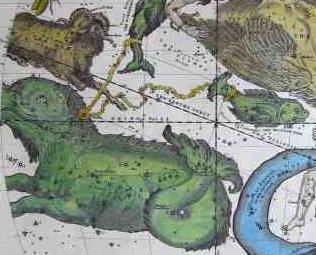 |
3.3 The Resurrection
The Ram (#8, Aries) is seen breaking the bands of death, and has been identified by all authors as representing Christ performing that very act. This is not a yearling lamb about to be sacrificed. This is an adult ram with horns, defeating the Sea Monster of death and hell.
Until I wrote this article, that general meaning seemed sufficient to me. But as the pieces all fell into place, it became more clear that the name of the role of Christ it represents is “The Resurrection.” That was a title for Christ, as in “I am the resurrection, and the life” (John 11:25). The implication that the Ram represents the Resurrection arises from the myths which accompany the figure. It is not always easy to evaluate the authenticity of a myth. It is my belief that when Enoch was given the constellation pictures, that he was either given some stories to accompany them, or that he wrote some stories himself. The myths which accompany the stars are very old and can be found in some form in Ancient Egypt, long before the Greeks.
The ancients all agree that the Ram is the Ram with the Golden Fleece which saved Phrixus from having been sacrificed by his father Athamas atop Mount Laphystium (a story very similar to Isaac having been saved from being sacrificed by Abraham in Gen. 22). The Ram appeared in the nick of time (like the ram in the thicket, Gen. 22:13) and swept him away to the Caucasus Mountains near the Black Sea. After arriving safely there, Phrixus sacrificed the Ram, and then its fleece turned to gold.[16] He presented this golden fleece to the king there. Later it became the object of the epic voyage of Jason and the Argonauts, which is also represented in the constellations.
Let me here propose that the Golden Fleece represents the body of the resurrected Savior, after he had been sacrificed, which shines with brilliant light. Being exposed to that light was enough to blind Saul on the road to Damascus (Acts 9:3-9). If the fleece represents eternal life, it would clearly be a worthy objective for the many heroes with Jason to pursue. Thus, it is here proposed that the Ram represents the Resurrection, breaking of the Bands of Death as depicted in the zodiac.
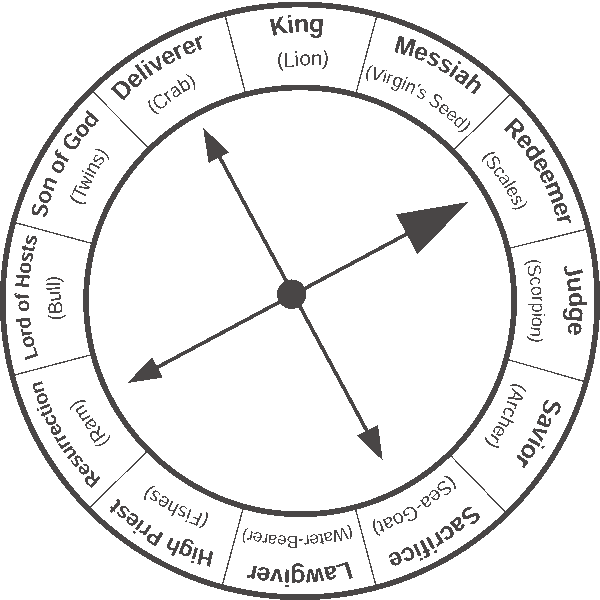 |
Three tasks in three days. Note that the three events proposed for these three constellations were accomplished in three consecutive days of history. The Great Sacrifice of his suffering and death was completed on Fri, 1 April AD 33 when the Lamb of God, without blemish, was offered to appease the demands of justice. The descent into the Spirit Prison to deliver the captives occurred on Saturday 2 April, which was Passover that year, the traditional time to free the slaves, as at the Exodus from Egypt. Finally, the Resurrection of Christ occurred on the morning of Sun 3 Apr, followed shortly afterward by that of many of the righteous who had been delivered from the monsters of both death and hell.[17] The fact that this set of constellations show so clearly these three essential steps of the redemption, and that they are spaced evenly around the circle, makes the evidence compelling that we have understood these constellations correctly.
4. The King of Kings
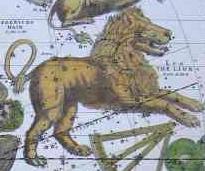 |
The Lion (#12 Leo) is the king of beasts, and to me clearly symbolizes Christ as King (Isa. 44:6). Much more was said on this subject in an earlier article, but here let it suffice to say that it was the symbol of the tribe of Judah from whom the kings of Israel descend until today.[18]
Anciently an all-powerful king or emperor tended to have all governing power, being able to make the laws, judge those who broke the law, and lead the armies and police to ensure that the laws were executed. In the United States, those three subdivisions of power are clearly separated into three branches of government: the legislative branch to make laws, the executive branch to enforce them, and the judicial branch to render judgments. Each of these functions has a name in the Old Testament as a role which the Lord fulfills. That is, he is called the Lawgiver, the Lord of Hosts (head of the army), and the Judge, each of which represents the head of one of those three bodies.
The three constellations which accompany the King serve to represent these very three functions, which makes this identification probably the most compelling. Let us look at each in turn.
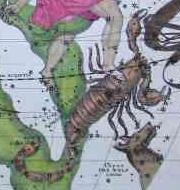 |
4.1 The Judge
The Scorpion (#3, Scorpius) is the symbol of the evil which attacks the people of God. But the Lord makes it clear over and over that it is he who brought the enemy to Israel to render the sentence of his judgment for commandments having been broken. Evil in general was often seen as the result of God’s judgment. One of the decans of the Scorpion is the Serpent, which clearly represents the same concept. The tribe of Dan adopted the serpent as its symbol, and the name “Dan” means “judge” in Hebrew. As explained in detail in an earlier paper, there is little doubt that the constellation of the Scorpion represents the Savior’s role as Judge.[19]
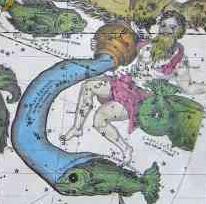 |
4.2 The Lawgiver
The Water Bearer (#6, Aquarius), seems to represent various aspects of the Lord as a provider of good things. The water being poured out onto the head of the fish seems to represent blessings in general, temple ordinances in particular, and knowledge. This constellation is associated with the intellect and knowledge. One role of Christ that it probably represents is Christ as the Master, meaning Master teacher. Most of the questions put to him as Master regarded the law of Moses.
As far as this comparison is concerned, it is the blessing of giving the law of Moses which is indicated. That was one of many blessings of knowledge given to the Israelites. Thus, among other things, it represents Jesus Christ as the great Lawgiver.
 |
4.3 The Lord of Hosts
In English, the meaning of this title in somewhat obscure. What hosts? In other languages the translation is more clear: it refers to the hosts of the army. The Lord is the head of army of Israel. This is essentially the function of the head of the executive branch of government, even as the President of the United States is the Commander and Chief of the Armed Forces.
The constellation of the Bull (#9 Taurus) exemplifies this role. It is an emblem representing great power, but it seems to be shown in a reclining position. The Book of Enoch makes it clear that the white Bull represents the Kingdom of God in the last days, and Moses refers to its two horns as pushing together the thousands of Manasseh and the ten thousands of Ephraim. Thus, it is proposed that in this sense, Taurus represents Jesus Christ as the Lord of Hosts.
These twelve proposals are summarized in the following table.
| Constellation | Name | Role of Christ |
|---|---|---|
| 1. Maiden | Virgo | Messiah |
| 2. Scales | Libra | Redeemer |
| 3. Scorpion | Scorpius | Judge |
| 4. Archer | Sagittarius | Savior |
| 5. Sea-Goat | Capricornus | Great Sacrifice |
| 6. Water Bearer | Aquarius | Lawgiver, Master |
| 7. Fishes | Pisces | High Priest, Holy One |
| 8. Ram | Aries | Resurrection |
| 9. Bull | Taurus | Lord of Hosts |
| 10. Twins | Gemini | Son of God |
| 11. Crab | Cancer | Deliverer |
| 12. Lion | Leo | King of Kings |
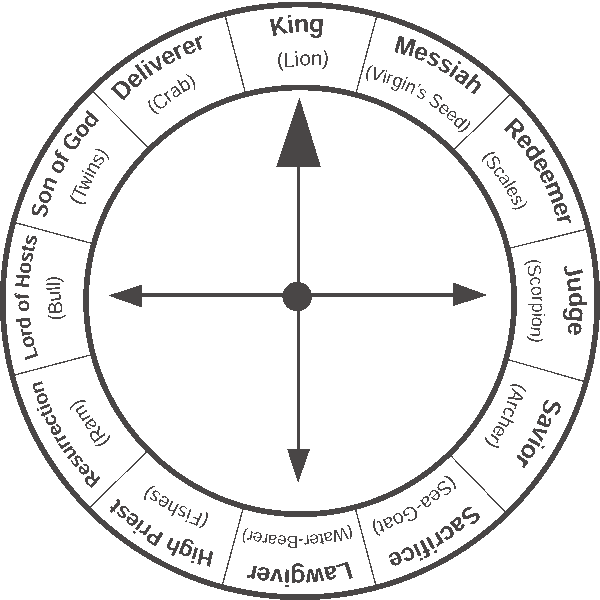 |
The fact that these twelve fit into three patterns of four, each of which has a head with three subdivisions, greatly strengthens the case that we have understood these roles correctly. Each of the three subdivisions are truly separate names for roles the Savior fulfills, and they are true subdivisions of the heading, and they are equally spaced around the circle. That is too much of a coincidence to have been caused by blind chance. Moreover, there are indications that this pattern may repeat at different levels within itself.[20]
5. Conclusion
The proposal made in this article that the zodiac constellations were designed to illustrate twelve distinct roles of Jesus Christ appears to be correct because 1) the figures are excellent choices to symbolize those roles, 2) the twelve break into three sets of four which are equally spaced around the circle, 3) each set of four has one as header and the other three as subdivisions of that heading, and 4) the constellations were reportedly revealed by an angel, which would imply that they should be closely tied to Jesus Christ. These meanings are proposed in addition to former work in this field which has suggested that the constellation figures also depict the gospel in chronological order, which may well also prove to be correct.
Notes
- Rolleston, Frances, Mazzaroth; or the Constellations (London: Rivingtons, 1862, updated in 1875), with the latter version reprinted by Weiser Books (York Beach, Maine, 2001). The brilliance of her work is to have recognized the overall pattern and to have done decades of research. Perhaps the best contribution from the ancient world was her summary of the Persian constellations.
- Seiss, Joseph, The Gospel in the Stars (Philadelphia: Claxton, 1882) reprinted by Kregel (Grand Rapids, Michigan, 1972) and Bullinger, E.W., The Witness of the Stars (London, 1893) reprinted by Kregel (1967).
- The main flaw is that part of Rolleston’s arguments were based on her translation of star names. She assumed most of the names were transliterated from Hebrew, which is just not true. Thus, nearly all of her arguments from star name translations are groundless.
- Pratt, John P., “Scientifically Dating the Constellations“.
- There is a list of the 48 traditional constellations, with pronunciations, on my astronomy website at www.johnpratt.com/items/astronomy/starnames/cons_names.html. My article introducing the concept that the constellations may be a witness of the gospel is “The Constellations Testify of Christ,” Meridian Magazine (9 Oct 2001).
- Pratt, John P., “Lost Constellation Testifies of Christ” Meridian Magazine (14 Jul 2004).
- Pratt, John P., “Review of Gospel in the Stars” (10 Jul 2004).
- Pratt, John P., “Answering Objections to Gospel in the Stars” (10 Jul 2004).
- Pratt, John P., “The Lion and Unicorn Testify of Christ, Part I: The Cornerstone Constellations,” Meridian Magazine (8 Nov 2001).
- Pratt, John P., “The Lion and Unicorn Testify of Christ, Part II: The Four Royal Stars,” Meridian Magazine (5 Dec 2001).
- The horns of the white bull are black (Enoch 89:47). Black appears to be Enoch’s color (ibid., sec 2.2), so those horns may represent the return of his city. If so, this symbolism shows the power of knowing what colors are associated with various constellations.
- Reuben is associated with the Water Bearer, Judah with the Lion, Dan with Scorpion and Joseph with the Bull. See article in footnote 9.
- It also clearly refers to the political Kingdom of God, which is the offspring of the Christ’s Church, represented by the woman who was given the wings of an eagle (Virgo), as in Rev. 12.
- Kunitzch, Paul, and Smart, Tim, Short Guide to Modern Star Names and Their Derivations (Wiesbaden: Otto Harrassowitz, 1986), p. 25.
- Pratt, John P. “Passover: Was it symbolic of His coming?” Ensign 24, 1 (Jan, 1994), pp 38-45.
- Some forms of the myth overlook this detail and assume that the fleece had been golden before. See Ian Ridpath, Star Tales (New York: Universe Books, 1988), which is an excellent summary of star myths, p. 30. But Richard H. Allen points out in his Star Names, Their Lord and Meaning (New York: Dover, 1963, p. 76), that the fleece turned to gold only after the ram was sacrificed, which fits the idea of resurrection perfectly. Here I would like to thank Thomas W. Mackay for helpful discussions both of the mythology and also the roles of Christ. It was he who advised me that if I omitted the role of Christ descending into the underworld and freeing the prisoners, that I would be missing one of the most important roles attributed to him by the early Christians. That discussion ultimately led to my discovery of the meaning of the Crab and the Deliverer, which might the most important contribution of this article.
- These four dates are proposed in Pratt, John P., “Dating the First Easter,” Ensign 15, No. 6 (June, 1985), pp. 59-68.
- Pratt, John P., “Geological Evidence for the British Throne of David?” Meridian Magazine (2 June 2003).
- Note that the Romans associated the Scales with Justice and had them being held by the Maiden. Hence the common symbol of the blindfolded woman holding the scales to represent justice. But in the constellations, it is the Scorpion who holds the scales of justice.
- One set of four constellations seems to be the master set with the other two sets being subdivisions. This provides an order to all three sets. In particular, the one constellation which appears to be the heading for all twelve is the Messiah or Christ (The Virgin’s Seed), which refers to everything that Jesus would do. It’s subdivisions are Savior, High Priest, and Son of God. The “Redeemer” set explains more about the details of the role as Savior, and the “King” set explains what the Royal Prince will do when he matures. I believe this added structure of patterns within patterns may well be correct, but it seemed too complicated to include in the main body of this article. Moreover, it is counterintuitive to the circular design of the zodiac.

